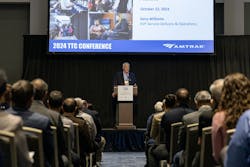Passenger rail transit is a critical aspect of the U.S. infrastructure system. A measurement of public transportation usage is passenger miles traveled (PMT), representing the total distance traveled by passengers across various transit modes. According to the Federal Transit Administration (FTA), in 2023 bus passenger transit accounted for 11.7 billion PMT while rail passenger transit had 20.1 billion PMT. This data highlights the importance of proportional investment in research to advance passenger rail transportation in the U.S. This article explores the topic further, shedding light on critical challenges and opportunities for growth.
Discussion at the 2024 TTC Conference & Tour
During this year’s Annual Transportation Technology Center (TTC) Conference & Tour, held Oct. 22-23, 2024, in Pueblo, Colo., a panel of experts shared their insights on the future needs of passenger rail transit research. Panelists included Molly King, deputy associate administrator at the FTA; Narayana Sundaram, senior portfolio director for the Signal Systems Renewal Program at the Washington Metropolitan Area Transit Authority; and Lisa Staes, associate director at the Center for Urban Transportation Research at the University of South Florida.
The panel engaged in a lively discussion about the critical research needs in passenger rail transport. A key theme was the substantial federal investment in passenger rail infrastructure, including rolling stock, tracks and other transit assets. However, the panelists noted that research and development (R&D) funding has not kept pace with this growth, particularly when compared to investments in bus-related research. Another important point raised was that passenger rail research should complement, rather than duplicate, efforts already underway in the freight rail sector.
In addition to the panel, Gery Williams, executive vice president of service delivery & operations at Amtrak, delivered the opening keynote speech. He outlined several of Amtrak’s priorities, including maintaining and improving overhead catenary systems. Amtrak operates approximately 457 route miles of overhead catenary track along the Northeast Corridor (Boston to Washington, D.C.), the largest such network in the U.S. Ensuring this infrastructure operates safely and efficiently is essential to Amtrak’s success.
Power infrastructure research
A distinct aspect of railway passenger transit compared to freight rail is its reliance on power infrastructure, such as overhead catenary systems and third rail systems. Maintaining and monitoring these systems are essential for safe and efficient operations and targeted research can enhance these efforts.
For overhead catenary wires, maintaining precise tolerances in both height (above the top of the rail) and stagger (lateral position relative to the track centerline) is critical. Deviations from these tolerances can lead to severe issues, including dewirement—the most serious outcome—where the pantograph extends beyond the catenary wire’s allowable range, snagging the wire and often tearing it down. Such incidents can cause significant operational disruptions.
Similarly, third rail systems must also stay within precise tolerances to avoid damage to the collector shoes on rolling stock, which can break or fail if the rail's position is incorrect. Additionally, third rail contamination or damaged insulators can allow stray current to escape to the ground, posing a fire risk. Detecting these conditions can be particularly challenging because the third rail exhibits its highest temperature only when current is flowing during active operations. During off-peak hours or between train services, the lower temperature makes identifying such issues more difficult.
An often overlooked, but important aspect of power infrastructure is the return current. For overhead catenary or third rail to energize a train, it must make a complete circuit. This means there needs to be an electrical connection from the train back to the electrical substation on a different route than the overhead catenary or third rail.
Often this is done with one or both of the running rails. However, this return current can go direction not desired when conditions deteriorate such as with damaged electrical cables connected to the running rails or fouled and wet ballast or standing water on slab track. Electricity takes the easiest path, which in these deteriorated conditions, can cause damage.
A common result is rail base corrosion, which is caused by the stray currents exacerbating the corrosion of the rail. If unresolved, this can result in a broken rail. Lastly, a critical, but often unseen aspect of power infrastructure is the substations themselves. Should failure strike a substation, it can cause significant delays to riders and therefore, requires optimum operational performance.
Through all these potential failure modes, there is the need for research to find the next generation of measurements, detections, preventions and mitigations. A unique aspect of the TTC is it is the only railway testing facility in the world that has both overhead wire catenary and third rail electrified test tracks.
The first is the Rail Transit Track Loop (RTT), which is 13.5 miles and is fully equipped with AC overhead wire catenary. The 15-megawatt substation that feeds the RTT catenary can be adjusted between 12.5 kV to 50 kV AC to match various configurations of transits around the U.S. The Transit Test Track (TTT) is a second electrified test loop at the TTC that is equipped with DC third rail and overhead wire catenary.
The TTC is fully equipped with DC third rail around its 9.1-mile circumference. Additionally, the TTC has a two-mile section of DC overhead wire catenary, which replicates streetcar and light- rail operations. Like the RTT, the TTT has two DC substations that can vary voltage to match the operating railway’s parameters. With this power infrastructure, not only can the TTC be used for testing rolling stock, but also for conducting power infrastructure research itself.
Key areas of research
In the last National Transportation Safety Board (NTSB) Most Wanted List published in 2023, the one and only item assigned to the railway sector was roadway worker safety associated with railway personnel working on track, particularly prevention of injuries or fatalities associated to railway personnel being struck by moving equipment. A key challenge that railway passenger transits will overcome is ensuring roadway worker safety even with higher train traffic and more frequent roadway workers walking on the track, as compared to freight railroads. Advancing technology through research then validating and testing at the TTC enables for continued increases in safety.
Positive Train Control (PTC) was enabled by research predominantly pushed by the freight rail industry. A similar opportunity stands with Communications-Based Train Control (CBTC), which is used significantly by heavy rail (subway). Through research, improvements to CBTC can be achieving increasing reliability and decreasing headways. Just like with PTC, CBTC also has an opportunity to help protect roadway workers and maintenance-of-way equipment with location detection and train control detection.
Railway passenger transits have a higher density of interaction with the public as compared to freight railroads. This is important in the way of trespassers, pedestrians and bicyclists crossing grade crossings and effects of noise and vibration on the public. Through research, innovative technologies and approaches can be tested and deployed to elevate riders and public interaction with public transit.
Lastly, a unique aspect of railway passenger transit research is that reliability and efficiency is also important. Getting riders to their destination is a crucial mission for public transit. Leveraging research, improvements can be made to ensure safe, efficient and reliable trips are made with existing and new passenger transit infrastructure.
Conclusions
During the 2024 conference, TTC emphasized it supports both freight and passenger rail through research, testing and workforce development. With its unique overhead catenary wire and third rail infrastructure, the TTC is equipped not only to test new passenger rolling stock, but also to advance power infrastructure research.
Emerging challenges, such as roadway worker protection, train control and trespassing, can be effectively addressed through the cutting-edge research and technology acceleration the TTC has pioneered for decades in the freight rail industry. Under its expanded mission, the TTC now brings this expertise to the passenger rail sector as well.

Matthew Dick | chief of strategy and development
Matthew Dick is the chief of strategy and development at ENSCO, with more than 14 years of experience in various roles, including rail division manager. He leads ENSCO’s expansion of service offerings, focusing on the Transportation Technology Center and subsidiary KLD Labs, Inc. Dick holds a B.S.M.E and M.S.M.E. from the University of Nebraska – Lincoln and is a licensed professional engineer, with more than 20 years of involvement in railroad research and technology, specializing in vehicle/track interaction, derailments and inspection technology.






